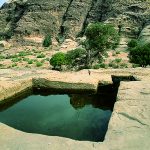The convention The Code of the Landscape of the Caves promoted in Matera by the ITKI – UNESCO was closed with the feast of bread
The “reaping ceremony” is a rite that is still perpetuated in San Giorgio Lucano with the staging of the sacrifice of the last sheaf made by mowers and the stripping of the virgin representation of death, expiation, fertility and rebirth. The ethnographic documentary filmed in 1959 by Lino Del Frà, “The passion of the grain” was presented at Palazzo Lanfanchi, in Matera, where the international UNESCO Conference “THE LANDSCAPE OF THE CAVES – The Cut Rock Cities Traditional Knowledge Proper Management of Ecosystems “, organized on the occasion of the 20th anniversary of the” Città dei Sassi “registration in the UNESCO World Heritage List and of the nomination of the Lucan capital as European Capital of Culture 2019, with the participation of the most qualified international experts. An event of great international interest because it is built on highly topical subjects: living in a cave; natural architecture; passive geothermal energy; the type of urban structure, which has now become a model for the most advanced bio-architecture research, on the sustainable city, the green economy and the issue of landscape quality, production, food, life and rebirth and land conservation. The Bread has become the true protagonist of the final day in a manifestation of a joyful crowd that has come to present the largest bread that the city of Matera and perhaps all of Basilicata have ever put on the tables. A record bread four meters long and weighing about 60 kilos, distributed to everyone in piazzetta Pascoli, where the faces and life of lucanity were seen, almost by magic, the same faces of the peasants framed in Pasolini’s Gospel in the Sassi of Matera and then portrayed by Carlo Levi in the work he painted for the Mostra delle Regioni held in Turin in 1961, as part of the celebrations for the centenary of the Unification of Italy. The large panel is now preserved in Palazzo Lanfranchi, where the event organized by ITKI UNESCO and Ipogea took place, with the support of Energeo as media partner. “Lucania 61” represents the most demanding pictorial undertaking by Carlo Levi, where the Turin writer and painter summarized the most salient motifs of his long speech on the South and on Lucania, “with its content of humanity, of ancient pain , of patient work, of courage to exist “. The author of Christ stopped at Eboli called them “the faces of the people”, in whose eyes destinies are set. They are the faces of a Lucania that still exists. Bread was the protagonist of the “Universal Bread Matera Capital” event conceived by the local poet Roberto Linzalone and organized by the Municipality of Matera and by the Superintendency of Artistic, Historical and Ethno-Anthropological Heritage of Basilicata to celebrate the 20 years of the city’s registration in the UNESCO list of World Heritage Sites and to celebrate all of Matera’s entry into the short list of candidate cities for the European Capital of Culture for 2019. Someone wanted to see in the bread placed on a cart typical of the Matera tradition, transported in a procession, offered to the population, a symbolic representation of the past. A ceremony that wanted to remember a cereal agriculture that does not know machines and does not go beyond the plow, the sickle and the threshing by hand or animal. But it will certainly go towards the future. In fact, human rights and dignity are the objectives to which UNESCO action on the landscape aims to build a fairer, fairer and more peaceful future.
Video summarizes some aspects of the conference and the party.









